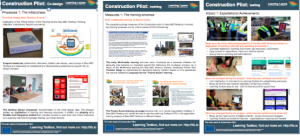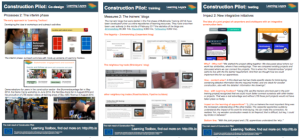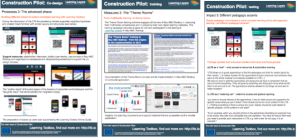Final Review of Learning Layers – Part Three: Comparisons between and reflections on the pilot sectors
In my two previous posts I have started a series of posts on the concluding event of our EU-funded Learning Layers (LL) project – the Final Review. In the first post I explained how we came to the idea to organise the event primarily at the Norddeutsches Zentrum für Nachhaltiges Bauen ((NZNB) – North-German Centre for Ecological Construction Work in Verden, near Bremen). I then gave a picture of the arrangements on site and on the special agenda of Review Meeting (with interactive exhibition spaces as addition to traditional presentations). In the second post I focused on the contributions of the Construction Pilot – on our topics and how we presented our message (with poster wall, exploitation tables and presentation session). In this third post I will focus on the comparisons between the Construction pilot and Healthcare pilot that I and Tamsin Treasure-Jones presented as tandem-presenters. (In the agenda this was labelled with the title “Future of Learning in digital transformation of SMEs” – led by Graham Attwell. Here I will focus on our reflections on the two sectoral pilots and on our conclusions from cross-sectoral comparison.)
Interests, obstacles and challenges for digital transformation in the pilot sectors
Looking back at the project start we presented the following interests, obstacles and challenges that had a role in promoting or preveing digital transformation in the pilot sectors:
In the Construction sector:
- Productivity of workforce was emphasised by the representatives of the umbrella organisation of the construction industry (Bauindustrieverband) as a major source of innovation to be be explored.
- Several pioneering enterprises had introduced earlier digital tools but made negative experiences with non-mature technologies and less user-friendly software solutions.
- Most construction companies had very restrictive policies regarding the use of mobile devices at construction sites – partly to avoid hazards due to lack of concentration, partly to ensure data protection and data privacy.
- Most apprentices were not familiar with domain-specific apps and had mainly used to digital tools and Internet for private hobbies and interests.
In the Healthcare sector:
- The pilot contexts were overshadowed by high workloads and high stakes. Therefore, time for reflection and learning was limited. Readiness for innovations was available, if one could foresee quick wins. The management representatives and staff were wary of technology that is not yet robust or fit for purpose.
- There was an increasing emphasis to have more collaboration (between teams and SMEs in healthcare) but this tended to create new demands on staff time, information overload and slow down decision making.
- In the SMEs usage of digital technology was limited due to lack of WiFi and reliance on traditional desktop computing.
Co-design, capacity-building and user engagement in the pilot sectors
Looking back at the activities in the two sectoral pilots, we can summarise the somewhat different developments in the following way:
In the construction sector:
- Participative Research & Development dialogue was primarily promoted in one central application partner organisation (Bau-ABC). It involved users (trainers & apprentices) and technical partners but was kept together by a supporting accompanying research team.
- The co-design process was based on preliminary idea that was revised in an iterative process that prepared the grounds for shaping an integrative and flexible mobile toolset. During this process the Multimedia training schemes had a bridging role in carrying the process to next phases and in promoting the users’ web competences for the piloting.
- Wider stakeholder engagement served the purpose of promoting the idea of an integrative toolset and getting new impulses and feedback for the co-design.
Co-design, capacity-building and user-engagement in healthcare:
- Co-design process was shaped with three parallel design teams – involving different sets of users, researchers and software developers from different countries and organisations.
- In general the activities were based on Design-Based Research process model and on several iterations. At the final phase of the processes they were reaching the stage of partial integration of originally separate tools.
- Training was built in into co-design and pilot activities but it couldn’t integrate the pilot groups and bridge the gaps.
- Pilots were extended to wider groups when initial user groups (involved in the design teams) encountered difficulties in making actual use of the tools in the context of work. Wider stakeholder engagement served the purpose of opening the piloting beyond the original co-design teams.
Signs of transformative practice in the two sectoral pilots
Looking at the experiences in co-design, capacity building and using the tools in the two sectoral pilots, we can summarise the achievements as ‘signs of transformative learning’ in the following way:
In the construction sector
- The Bau-ABC trainers’ work with their own domain-specific blogs and their project-specific stacks for Learning Toolbox helped them to create ownership of digital tools and confidence to use them. Likewise, the apprentices accepted the use of digital tools and web resources as welcomed enrichment of their learning practices.
- Some Bau-ABC trainers used Learning Toolbox as an instrument to plan integrated training projects. In this way they could address working interfaces at construction. From the perspective of productivity and energy-efficiency these interfaces (e.g. in the work of bricklayers and carpenters) are of vital importance. Here the engagement of the two trades in joint projects (which require familiarisation in the other trade’s tasks) can be seen as a major step in developing collaborative projects of different trades.
- The presentation of Thomas Isselhard on Learning Toolbox in the coordination of work at a construction site (see Video 1 and Video 2) give a clear picture of the advantages of using Learning Toolbox by different parties.
- Yet, the positive examples referred to need to be seen as ‘instances of change’ which require further support by management decisions and by engagement of further users (see the next point below).
In the healthcare sector
- The workshops of the Healthcare pilots also managed to create ownership through co-design – such as the participants’ engagement with “our Bits & Pieces” applications.
- The workshops facilitated moving from a culture of cooperative (externally coordinated) to collaborative (mutually coordinated) work – overcoming fears around change of own & others’ work.
- The pilot activities enabled a wider group to act as developers of new ideas, not only as reviewers (of the usability of the tools).
- Yet, the above mentioned learning experiences in the project activities were not enough to overcome the hurdles in the organisational everyday life (see the next point below).
Lessons from the project work (altogether) in the two sectoral pilots
Lessons from construction pilot
- Major part of the co-design, capacity-building and piloting activities took place in the training centre Bau-ABC. It was relatively easy to integrate the activities into the training projects. Also, given its various training activities Bau-ABC was in a position act as a multiplier-organisation in its various networks. This is also the case with the Verden-based Netzwerk Nachhaltiges Bauen ((NNB) – Network for Ecological Construction Work).
- In the pilot activities the Learning Toolbox proved to be a flexible toolset that could be easily customised to support trade-specific learning as well as coordination of construction work at construction site.
- Concerning the roll-out to construction companies, it has been essential to demonstrate the Learning Toolbox at the stage of ‘working tool in action’ to get construction companies start their own pilots. These, however require a greater degree of customisation and integration of ‘learning’ with the optimisation company-specific work and business processes.
Lessons from healthcare pilot
- Major part of the co-design, capacity-building and piloting took place in General Practice stations – in which there was less time and space for introducing new tools and practices in the middle of daily work. In the exploitation phase it became clear that organisations that are responsible for education/training of healthcare professionals are in a better position to start the initial piloting.
- The pilot activities in Healthcare sector focused on tools that were designed for collaborative use (across the organisation or particular networks or teams). It appeared that in many cases there was a risk of ending up with parallel processes (for those using the tools and those not getting involved) and therefore the use of tools could not be established as a general practice. In this respect the use of Learning Toolbox has been less dependent on the number of users within the organisation.
- Also in the exploitation activities in Healthcare sector it has been important to have examples from using the tools in real work settings to facilitate transfer of innovation beyond the original contexts (the organisations involved in co-design activities).
– – –
I believe that this is enough of the comparisons between the two sectors. In my next post I will give a picture on the questions raised by our presentations, on the related discussion and on the feedback from reviewers.
More blogs to come …



